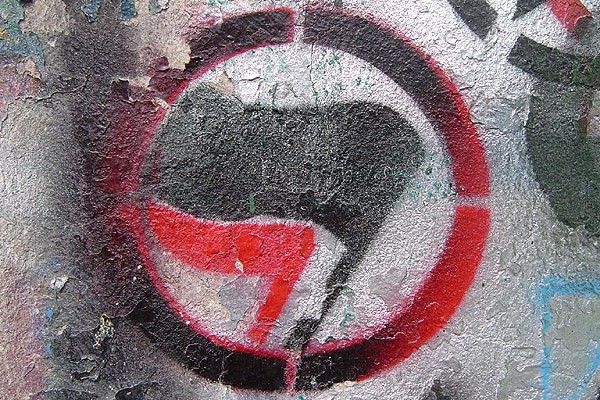With Donald Trump all but endorsing the recent fascist rally in Charlottesville, and liberals in the US and Australia suddenly coming around to the importance and legitimacy of antifascism, it’s worth taking a step back to look at what fascism is, where it comes from, and how to stop it.
To start with, although we have seen nothing quite like the horrors of Charlottesville, fascism is currently alive and all too well in Australia.
The most recent fascist rally in Melbourne was held by the True Blue Crew, along with their allies from the United Patriots Front, the two major fascist organisations that have been rallying in Victoria over the past two or three years. Here are some excerpts from the event description of their rally on 25 June:
Our Australian national pride, heritage, culture and way of life are now constantly under attack from ‘leftists’ and various un-Australian traitors.
The anti-Australian agenda to destroy Australia Day, Anzac Day, and any remaining Australian pride is gaining momentum. The push for the all round destructive concept of ‘political correctness’ is preventing us from pointing out those that are a problem for our community.
Their agendas of, increasing immigration / refugee intake which will only further clog our roads, public health system, increase unemployment, and make it harder for Australians to afford a home; closing refugee centers which will see a return of the people smuggler boats to our shores and further threaten our national security; and gender bending programs forced on our children such as ‘Safe Schools’; are all unrelenting.
They then go on to talk about ‘African crime gangs’, terrorism and an entire extra paragraph on the dangers of Safe Schools.
In order to understand the agenda of the True Blue Crew and similar groups, I have outlined six theses on fascism, informed by my research on Australian Jewish antifascism in the forties and fifties.
Thesis one: Fascism is reactionary and exists on a spectrum of reactionary politics
Despite the appeals to national pride and traditional morals in the Facebook event, these concepts remain largely nebulous or seemingly self-explanatory abstractions. Instead, the True Blue Crew draw on a grab bag of nationalism, sexism, homophobia and racism – all of which is explicitly posed as oppositional to social change and the dismantling of social hierarchies (understood here as progressive political correctness and a racialised threat from migration).
In the 1920s and 30s, the international left theorised fascism as a counterrevolutionary movement, heading off the spectre of Communism in a moment of crisis. But today’s fascist mobilisations manifest in a situation where there is not the least threat from a left revolutionary force. Without the threat of revolution, various other anxieties associated with reactionary politics are invented, jumbled together and radically exaggerated to project an image of a monolithic threat that a fascist movement can prevent.
While it is fair to say that fascist groups such as the United Patriots Front and the True Blue Crew are quite marginal, the ideas expressed in this event description are certainly not. In fact, they express in crude terms ideas that are parroted daily in the Murdoch press and given representation in parliament by One Nation and politicians like Cory Bernardi and George Christensen. There is a discourse here that runs across a recognisable reactionary spectrum, from Blair Cottrell of the United Patriots Front to Chris Uhlmann repeating alt right talking points on cultural Marxist infiltration to Malcolm Turnbull being unafraid of using veiled racist rhetoric on terrorism, refugees or citizenship tests to prop up his failing prime ministership. There was no better display of how integral a racist worldview is to large segments of Australia’s ruling class than the Bill Leak love-in occasioned by the cartoonist’s death, while just recently the Institute for Public Affairs endorsed Avi Yemini’s planned fascist Islamophobic rally in Sydney.
There’s a revealing section in John Safran’s new book, Depends What You Mean by Extremist, where Safran runs into Cottrell at a rally and asks him to explain the downturn in attendance in far-right rallies, which started with over 1000 people at Reclaim Australia in April 2015 and had dwindled to around 50 people at the most recent Melbourne rally. Cottrell essentially says that with the return of Hanson to politics and the victory of Trump, Islamophobia is now so mainstream that it has ceased to be a force for fascist mobilisation. The fascists can sit back and relax while politicians and mainstream media propagate their views.
Thesis two: Fascism is necessarily antisemitic
Leaving aside a political analysis of the Trump administration itself, what is new and more threatening are the elements of Trumpism that have been mainstreamed as part of his political rise. Of course this was most recently demonstrated with the horrifying events in Charlottesville where Nazis and white supremacists rallied along explicitly anti-Black and antisemitic lines. Figures such as Steve Bannon and others associated with both the alt-right and the Trump administration mobilise – in the same way as the True Blue Crew – a reactionary civilisational discourse of embattled whiteness, ‘traditional values’ against a ‘politically correct’ left and, more broadly, against foreigners, refugees and Muslims, which is all assimilated into one idea of a racialised other threatening and undermining an imagined society.
This imagined society is premised on an image of a prosperous post-war racially homogenous nation centred on the nuclear family and traditional gender roles. This is expressed not in the manner of traditional conservatism but in a conspiratorial worldview that utilises anti-political populist rhetoric to polemicise not against the current political system as a whole, but rather at deemed ‘special interests’. In this rendering, foreign or undermining elements have captured power or are in danger of capturing power and thus need immediate excision. It is this style of fake critique – of being radically against the system, while refusing to actually critique or understand the system as a whole – that leads to a conspiratorial worldview. It is this idea of conspiracy that means that antisemitism, or something akin to antisemitism, is so necessary to fascist thinking.
In this thinking, some identifiable and excisable minority needs to be calling the shots. While Islamophobia is certainly the flavour of the month in terms of conspiracy thinking (intimately connected to justifying a never-ending ‘war on terror’), the current manifestation of Islamophobia is historically and conceptually intertwined with antisemitic thinking. This is most obvious in the prevalent idea on the Australian far right (not unlike Chris Uhlmann’s fantasies about the Frankfurt school) that Jews are trying to undermine White Australia through pushing pro-multicultural, pro-migration policies.
Thesis three: Fascism is transnational
This type of racialised civilisational conspiracy thinking stretches across national boundaries and makes the current far right rise internationally, much more than simply a resurgent nationalism. It is a major difference between Pauline Hanson and One Nation mark one and two. Mark one was anti-Asian with a strong emphasis on economic protectionism. Mark two is chiefly characterised by conspiracy thinking, and is keyed into an international Islamophobic discourse linked to an international idea of white/western civilisation under threat. As I’ve argued previously, despite claims of nationalism and patriotism, fascism then and now works as a transnational racial ideology; nation-state institutions are only a means to an end.
Thesis four: Fascism is anti-egalitarian
The other issue that distinguishes fascist ideas from the far right more generally (and this is a line that Hanson hasn’t yet stepped over) is that reactionary politics are not sold with lip service to conventional right-wing tropes of tradition or meritocracy but involve an explicitly anti-egalitarian ideology. There’s a connection here too with the growth of men’s rights activism, particularly online. In this discourse, open misogyny is praised and men are seen as being literally superior to women. It’s the same sort of thinking that informs racial thinking, believing in the reality of racial difference (coded either biologically or culturally) and that certain races are superior to others.
Thesis five: Fascism is a movement without a coherent set of ideas
There is a lack of positive or coherent content to these proto-fascist ideas. As put by the Jewish Communist author Judah Waten in 1950:
fascism grows up as a movement without an ideology in the sense of a distinctive and systematic doctrine and world outlook. There is only a practise, and to cover this practise, a medley of borrowed slogans from any and every theory, principle, or institution which may serve the purpose of the movement.
Not only are fascist ideas defined wholly in the negative and wholly in reactionary terms, but the methods of fascist organising and leadership style mean an emphasis not on autonomy or political conviction, but on fantasies of self-submission into an organic whole, combined with having power over others. While these groups or sub-cultures ‘may appear “fanatical” their conviction is hollow, if not at all the less dangerous for that’. There is a connection between alt-right and fascist ideas, and the cultures of purposefully offensive internet trolling and memeing. This thesis also explains the endless splitting and sectarianism among these micro groups, which are borne out of theatrical rival personality cults rather than as a result of actual ideological differences.
Thesis six: Fascism needs to be understood in a political and economic context
It is still useful to retain the fascist label and be careful who we use it with – but fascism does not exist in a vacuum. We should also oppose less obviously fascist political formations that enable fascism. Attention needs to be paid to the political and economic roots of the disease. Thus, an antifascist politics cannot only oppose people with swastika tattoos who proclaim their appreciation of Hitler.
This was something the Jewish left in the 1940s and 50s were well aware of, which is why their antifascist politics extended to imperialism, racism and reaction more generally. Antifascists of today need to learn the lessons of the Popular Front era; we have to recognise the complex and contradictory history of the official state antifascism of the past (for example, Don’t Be a Sucker). The European popular antifascism’s alliance with imperial states often meant forestalling anti-imperialist solidarity campaigns. Energies unleashed by a popular antifascism in the US encouraged and combined with militant anti-racist and anti-imperialist movements aimed at dismantling American empire and racial oppression, while, in Australia, William Cooper famously drew the parallels between European fascism and an Australian fascism that targeted Indigenous people.
Elements of the far-right politics discussed above have existed in various forms throughout Australian history. Structural racism, particularly anti-Aboriginal racism, is endemic to Australia as a settler colonial state. Current Islamophobic and antisemitic thinking in part recombines Orientalist and anti-Chinese tropes that have existed in Australia since before Federation.
In conclusion, I would say this: there are elements to this type of populist, reactionary, civilisational and conspiratorial racist worldview that are new. This type of thinking has become newly mainstream as a result of two interlinked crises: that of the ongoing effects of the 2008 economic crisis, and the crisis of legitimacy of mainstream politics, manifested in Australia with our quick succession of prime ministers over the past few years. While the certainties of a political settlement based on a pattern of seemingly easy and unending economic growth disappear, the social forces dominant in society struggle to find new ways of legitimating their rule. The mainstream politics of neoliberal technocracy – the basis for the policies of the two major parties – have been thrown into question. It is here that openly reactionary civilisational and conspiratorial narratives can find their purchase. This is nowhere better expressed than with that famous, slightly mistranslated, yet entirely appropriate Antonio Gramsci quote – ‘The old world is dying, and the new world struggles to be born: now is the time of monsters.’
A version of this article was presented as a longer paper at the University of Melbourne on 16 August 2017.
Image: Antifa






